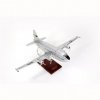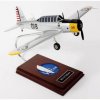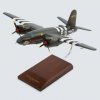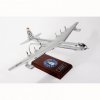"The Douglas C-124 Globemaster II, also known as ""Old Shakey"", was a heavy-lift cargo military aircraft manufactured by the Douglas Aircraft Company in Long Beach, California. C-124s provided heavy airlift during the Korean War, Southeast Asia War and other important airlifts such as re-supply missions to Antarctica, refugee evacuation in the Congo and mercy flights to Morocco, Chile and elsewhere throughout the world following floods and other natural disasters. It could lift 33.560 kilograms (74,000 pounds) of cargo. Its double-decked cabin could also be fitted with 200 seats for troops, or with 123 litters for casualty evacuation. Flight crew was six. The C-124 first flew on November 27, 1949. This C-124C variant of Globemaster was manufactured by Douglas Aircraft Corporation at Long Beach, California, and delivered to the U.S. Air Force on May 4, 1955. The aircraft was assigned to the 15th Air Transport Squadron (Heavy) of the Military Air Transport Service (MATS) operating out of Dover AFB, Delaware. The C-124C featured uprated engines, an APS-42 weather radar with a distinctive nose ""thimble"" radome, and wingtip-mounted combustion heaters to provide cabin heating and wing de-icing. The radar and combustion heaters were retrofitted to most C-124As. At the type's peak in 1963, there were 377 C-124s in service with 20 transport squadrons. A total of 243 C-124C were built. "
Wing Span: 21
Length: 15.5
AC124T
|
"The BT-13 Valiant is a basic trainer aircraft of World War II manufactured by Vultee Aircraft and was designed by Richard Palmer. The BT-13 Valiant was flown by most American pilots during World War II. The BT-13 incorporates a more powerful engine and was faster and heavier than the primary trainer. The BT-13's maiden flight was on March 1939. The BT-13 had served its purpose well and it made a good aircraft to help transition many hundreds of pilots toward their advance trainers and fighters yet to be mastered. The BT-13 has a crew of two, for a student and instructor. It has a maximum speed of 180 mph and a range of 725 miles. It incorporates a Pratt & Whitney R-985-AN-1. The primary users and oerators of the BT-13 are the USAAF and the US Navy. Curently, some BTs including the BT-13s are still flying, though there were only limited numbers. Postwar, virtually all were sold as surplus for a a few hundred dollars each. The BT-13 production run outnumbered all other Basic Trainer types produced. "
ABT13
|
The Douglas C-47 Skytrain is a military transport aircraft that was developed from the Douglas DC-3 airliner. It was used extensively by the Allies during World War II and remained in front line operations through the 1950s with a few remaining in operation to this day.
This model is personally signed by William “Wild Bill” Guarnere from the Band of Brothers. He earned the nickname "Wild Bill" and lived up to it; he was terror on the battlefield and had a reckless attitude towards the Germans. Guarnere received the Silver Star for combat during D-Day, and was later decorated with two Bronze Stars and two Purple Hearts. Certificate of Authenticity included.
This handcrafted model is painstakingly built from Philippine mahogany by our skilled craftsmen with a wealth of detail and makes a great gift for any veteran, aviation enthusiast or history buff.
Scale: 1/62 scale
Wing Span: 18
Length: 13
AC047BBSS
|
"The C-47 Skytrain is a military transport based and developed from the DC-3 and was used extensively in world War II. It was manufactured by Douglas Aircraft Company. The C-47 has proven itself for the success of many Allied campaigns, including Guadalcanal, New Guinea and Burma with its ability to counter the mobility of the light-traveling Japanese army. The C-47s were also used to airlift supplies to the embattled American forces during the Battle of Bastogne. The C-47 became notable for flying The Hump from India into China. From 1946 to 1947, the C-47s saw service with the USAF Strategic Air Command. The C-47 was also used by the Americans during the initial stages of the Berlin Airlift and subsequently, it was replaced by the C-54. The C-47 also played various roles including the AC-47 gunships and the EC-47 for counterintelligence during the Vietnam War. The C-47 was also acquired by the Royal Canadian Air Force for search and rescue operations in 1940-1950. The C-47A is a variant of the C-47 with a 24-volt electrical system and there were 5,254 C-47As built. The primary users of the C-47 are the U.S. Army Air Force, U.S. Air Force and Royal Air Force."
Scale: 1/72 scale model
Wing Span: 16
Length: 11
|
"The Douglas C-47 Skytrain is a military transport derived from the DC-3 airliner. Considered the greatest airplane of its time, the DC-3 did not go unnoticed by one of Douglas's oldest customers, the United States Army. In 1940, a large order was placed for the military DC-3, which was designated C-47. By 1941, the US Army Air Force had selected the C-47 as its standard transport aircraft. A reinforced fuselage floor and the addition of a large cargo door were the only major modifications. For both airline and military use, the aircraft proved to be tough, flexible, and easy to operate and maintain. As a supply plane, the C-47 can carry up to 6,000 pounds of cargo. It can also hold a fully assembled jeep or a 37 mm cannon. As a troop transport, it can carry 28 soldiers in full combat gear. As a medical airlift plane, it can accommodate 14 stretcher patients and three nurses. The ubiquity of the Skytrain and its ability to operate from very rough forward airstrips made it familiar to Allied forces stationed around the world. It not only pioneered in-theater wartime routes but also served as a VIP transport, general personnel transport, troop carrier, cargo transport, paratroop assault transport, glider tug, airborne ambulance, air-sea rescue craft, and special operations aircraft. "
Scale: 1/72 scale model
Wing Span: 16
Length: 11
AC047ST
|
The Fairchild AC-119G Shadow was a twin-engine piston-powered gunship developed by the United States during the Vietnam War. By late 1967, the idea of the fixed-wing gunship had been proven so successful that the United States Air Force was having a difficult time keeping up with demand. These aircraft were primarily intended to replace the AC-47 in the close air support role. and were placed in the 71st Special Operations Squadron (SOW). They were used by the SOW from 1969–1971.
This handcrafted model is painstakingly built from Philippine mahogany by our skilled craftsmen with a wealth of detail and makes a great gift for any veteran, aviation enthusiast or history buff.
Wing Span: 18.75
Length: 14.75
AC119T
|
"The B-26 Marauder is an American Second World War twin engine medium bomber made by the Glenn L. Martin Company. In 1942, it was the first bomber in the Pacific Theater and Aleutian Islands. In 1946, it was the main offensive weapon of the Western Front by the Army Air Force. The B-26B sustained the lowest record of any fighter aircraft during the war. Its loss earned its unofficial nickname “The Widowmaker.” There were 5,288 aircrafts produced between the years 1941 to 1945. The Royal Air Force and the South African Air Force used 522 of them. The B-26B Marauder first came out in May 1942. It was the Marauder model that was built in large numbers. The difference between the B-26B from the earlier versions of the Marauder aircrafts is the two .50 inch machine guns with 1500 rpg placed in a stepped down tail position. It replaced the B26 and B-26A single hand-held guns. The guns are used manually by bead sight and ring. The gunner kneels down to find his targets and shoots his armaments. The ammos are on the cartridge belts standing on a pair of roller tracks. Each of the guns has 800 rounds. The overall length was increased to 58 feet and 3 inches because of its new tail position. The B-26C was similar to the B-26B. But all B-26C aircrafts were made with a larger wing. In fact, it was the first Marauder version to show with a larger wing. The wing was showed on the Omaha line before it showed on the Baltimore line. Its wing span turned to 712 feet and the area of the wing increased to 713 sq. ft. The modifications made, such as the additional weapons and armor and its enlarged wing and tail assembly, increased the weight by 1500 lbs. The top speed at 15,000 feet decreased to 282 miles per hour and cruising speed decreased to 214 miles per hour."
|
The A-26 Invader (designated B-26 between 1948–1965) was a United States twin-engined light attack bomber built by the Douglas Aircraft Co. during WWII. The B-26 was an unusual design for an attack bomber of the early 1940s period, as it was designed as a single-pilot aircraft. It was found to be a fast aircraft which was capable of carrying twice its specified bomb load.
This handcrafted model is painstakingly built from Philippine mahogany by our skilled craftsmen with a wealth of detail and makes a great gift for any veteran, aviation enthusiast or history buff.
Scale: 1/48 scale model
Wing Span: 16.5
Length: 13.5
AB26T
|
"The B-29 Enola Gay is the most complicated and propeller-driven bomber aircraft in the Second World War. The crew quarters are in the b29's pressurized compartments and the aircraft has highly developed armaments and avionics systems. It brought the first nuclear weapons used in the Pacific Theater war. Colonel Paul W. Tibbets Jr. dropped the first atomic bomb “Little Boy” in Hiroshima, Japan. The strategies for the first atomic bombing were set in August 1945. There were seven Superfortress aircrafts, three of which were to scout in front. One of them is to measure the blast of the bomb, and one photo plane is assigned to be the standby plane and the primary plane. The aircraft’s bombing is visual not radar. They used it to target the cities of Hiroshima, Kokura, Niigata and Nagasaki. Paul Tibbet’s own aircraft decided to name it “Enola Gay” after his loving mother. This gave him inspiration while he was building it. The Enola Gay allows 12 crewmen. In the afternoon of August 5, the Americans placed the bomb into the Enola Gay plane. The “Little Boy” atomic bomb is 12 feet long and 28 inches in diameter. Its power matches up 20,000 tons of TNT or approximately as much as two thousand Superfortress aircrafts could take. They started their engines in August 6, 1945 at 2:30 AM. Three hours after, they flew over Iwo Jima at dawn, where 5,500 Americans and 25,000 Japanese had died, so that the USAAF could use Iwo as an emergency landing field. They altered course and went northwest. They climbed to 30,700 feet for their bombing altitude. And at 8:30 they got a coded message saying Hiroshima was covered with clouds. At 9:15AM they dropped the ""Little Boy"" and made a 155 degree diving turn to the right. "
AB29ET
|
The Boeing B-29 was the most complex aircraft of the first part of the century. Service delivery of the B-29 began in 1944, with the first combat mission flown on June 5, 1944. This specific B29 model is painted as “Enola Gay,” which was the aircraft that dropped the atomic bomb “Little Boy” during the final stages of World War II.
This model is personally signed by Theodore “Dutch” Van Kirk, Enola Gay Navigator, and Morris Jeppson, Weapons Test Officer. Unfortunately Jeppson passed away in March 2010, leaving Van Kirk as the last living survivor from the crew. Certificate of Authenticity included.
This handcrafted model is painstakingly built from Philippine mahogany by our skilled craftsmen with a wealth of detail and makes a great gift for any veteran, aviation enthusiast or history buff.
Scale: 1/72
Wing Span: 23.75
Length: 17.00
AB29TSS
|
The B-29 Superfortress is a four-engine propeller-driven heavy bomber. It was one of the largest aircraft to see service in World War II and a very advanced bomber for its time, with features such as a pressurized cabin, an electronic fire-control system, and remote-controlled machine-gun turrets. Originally the B-29 was designed as a high-altitude daytime bomber, but it was used extensively in low-altitude night-time incendiary bombing missions. It was the primary aircraft used in the American firebombing campaign against the Empire of Japan in the final months of World War II and was used to carry out the atomic bombings that destroyed Hiroshima and Nagasaki.
This specific B-29 model is painted as "Lucky 'Leven", Clinton Rogers' airplane. He was part of the 73rd Bomb Wing and was stationed on the island of Saipan; Rogers and his crew flew 39 bombing missions over Japan and other Pacific islands.
This handcrafted model is painstakingly built from Philippine mahogany by our skilled craftsmen with a wealth of detail and makes a great gift for any veteran, aviation enthusiast or history buff.
Scale: 1/72 scale model
Wing Span: 23.75
Length: 17
AB29T
|
"Six pusher radial engines, mounted on the trailing edge of the wings, powered this big long-range SAC bomber. The D, ""burn and turn"", model was boosted by a pair of turbojet pods under the outer wings. A strategic bomb built by Convair for the United States Air Force. The Convair B36 Peacemaker is said to be the very first bomber that had intercontinental range and was also the first thermonuclear weapon delivery vehicle. The Peacemaker was the largest combat aircraft ever built. Its 230 foot wingspan is almost fifty percent longer than that of the huge B-52 that replaced it. The B-36 was one of America’s major deterrents to violence by a prospective adversary for eight years. From 1948 to 1958, the B-36 became part of the USAF Strategic Air Command. Major General Henry Arnold described the B-36 as the plane that could “fly the skin off any rivals”. The Peacemaker was also the first Cold War Bomber. Unlike any other aircraft that were seen in wars dropping bombs or firing an enemy, the B-36 was never seen in any of these actions. Instead, the Peacemaker was closest seen during the 1956 Hungarian Revolution and the Suez Crisis where it was dispatched to Turkey and Morocco. Thus, the Peacemaker is famous for never having fired a shot in anger and the plane that kept peace for ten long years. The B-36 Peacemaker was also involved in two aircraft collapse incidents, one was last February 13, 1950 in an unpopulated region of British Columbia and it was the first loss of an American Nuclear Weapon. The other one was on May 22, 1957 when a B-36 accidentally dropped a bomb on a deserted area while landing at Kirtland AFB in Albuquerque. A total of 388 B-36 Peacemakers were produced. The last one was built on August 1954. Then on June 29, 1955 the first B-52 was delivered to SAC. All Peacemaker models were delivered and converted to J models on which two jet engines were added to each wing. The last B-36 Peacemaker made its final flight in 1959."
AB36
|
The B-36 "Peacemaker" was a strategic bomber built by Convair and operated solely by the United States Air Force from 1949 to 1959. The B-36 was the largest mass-produced piston engine aircraft ever made. It had the longest wingspan of any combat aircraft ever built, although there have been larger military transports. The B-36 has a range greater than 6,000 mi and a maximum payload of 73,000 lb, which made it the world's first manned bomber with an unrefueled intercontinental range and set the standard for subsequent US intercontinental bombers. The B-36 was the primary nuclear weapons delivery vehicle of the Strategic Air Command, until replaced by the the jet powered Boeing B-52 Stratofortress.
This handcrafted model is painstakingly built from Philippine mahogany by our skilled craftsmen with a wealth of detail and makes a great gift for any veteran, aviation enthusiast or history buff.
Scale: 1/100 scale model
Wing Span: 27.75
Length: 20.25
AB36T
|
"The B-24 Liberator was a four-engined heavy bomber built by Consolidated Aircraft. It was produced in greater numbers than any other American combat plane during World War II and still holds the record as the most produced US aircraft. It was used by every branch of service during the conflict, earning a distingushed war record with its operations in the European, African, Pacific and Middle Eastern theaters. The PB4Y-1 Liberator was the navalized version of the B-24. The Liberator was notorious among American air crews for its tendency to catch fire from battle damage because of the placement of its fuel tanks and its lightweight construction. It was more difficult to fly as well, with more instruments and switches facing the pilot and more training required before proficiency was achieved. However, the Liberator excelled over other contemporary World War II heavy bombers in versatility. It had a long operating range, which led to it being used for various duties including maritime patrol and anti-submarine work, reconnaissance, tanker, cargo and personnel transport. Winston Churchill used one as his own transport aircraft. A total of 18,482 Liberators were built by September 1945. The US Navy acquired 977 PB4Y-1s, which were used in sinking U-boats, photographic reconnaissance and transport during the war. In 1944, two modified PB4Y-1s were used in Project Anvil as pilotless flying bombs to take out a German V-2 installation in occupied France. The aircraft were fitted with remote control gear, a forward-looking television camera and 25,000 lbs of explosives. "
AB24Y1
|
"The North American B-25J Mitchell was an American twin-engined medium bomber developed by the North American Aviation. The aircraft was used with devastating effect against German and Japanese targets in every battle scenario of World War II. The B-25J Mitchell was named General Billy Mitchell, an American general known as one of the most famous pilots in American airpower history. He was called the Father of the U.S. Air Force. The B-25 Mitchell took its first flight on August 19, 1940. It is powered by two Wright R-2600-9 Cyclone engines which delivered an amount of 3,400 horsepower. The aircraft's highest speed is 355 mph. The original airplane had difficulties during bombing runs, so the dihedral in the outer wing panels was eliminated on the 10th B-25 version onwards. The B-25J has 4,318 units. It is considered to be the most widely produced version of the Mitchell. The B-25 saw many modifications during its operating service. The series ran from the B-25A to B-25J, each type seeing variations to increase its firepower. The first 25 were armed with a. 30-caliber Browning in the nose and one at each waist position. For security, the tail of the aircraft sported a .50-caliber Browning. A Plexiglas nose and a turret gunner originated with the B-25B. The B-25G also had a retractable belly turret. "
AB25EST
|

















